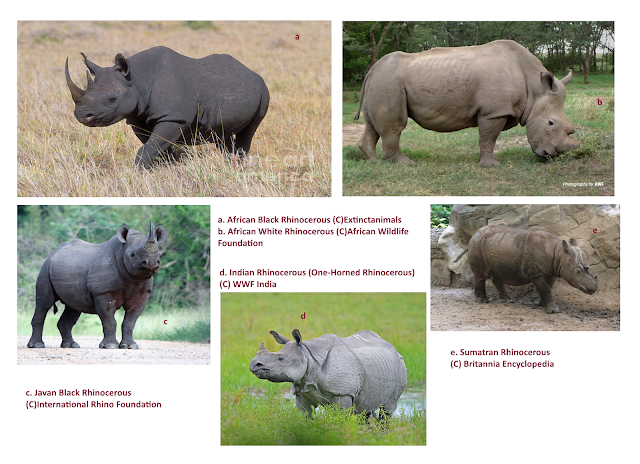Rhinoceros have been one of the oldest species and are endangered in the grim of extinction. There are five extant species of rhino available in the wild, which are:
1. Asian Rhino: a. Javan Rhinoceros (Critically Endangered); b. Sumatran Rhinoceros (Critically Endangered); and c. One-horned or Indian Rhinoceros (Vulnerable)
2. African Rhino: a. White Rhinoceros (Near Threatened); and b. Black Rhinoceros (Critically Endangered)
The difference between the Asian and the African Rhino is the absence of teeth in the African Rhino which pluck the leaves (food) using lips. Other food will include fruits, grass, and farm crops. The ones that stand out are the Sumatran Rhinos, the smallest of all of them that are dark-red brown with short, stiff, and dark-coloured hair.
A general description of any species of the rhinoceros that interest us is their stumpy legs, barrel body with one or two dermal horns (not of bones). Rhinoceros do not attack humans unless instigated and their eyesight is of no use in a fight; however, they have a very good sense of smell and hearing. These semi-nocturnal animals sleep by standing or by sitting and love playing in muddy pools and sandy river beds.
What makes Rhino the talk of the town of smugglers, especially when banned are their medicinal values and dagger handles. Moreover, rhinos are facing threat to survival for want of habitat, the forests. Thus WWF does its part to conserve Rhino through different programmes like AREAS (Asian Rhino and Elephant Strategy), African Rhino Programme, and Wildlife Trade Campaign to create awareness and financial support required for the conservation of habitats and the animals.
African Rhinos live for about 35 to 40 years in the grasslands and savannahs with humans as the only predators. They are fast runners galloping at a speed of 30 miles per hour and are strictly herbivores. These thick-skinned and small-brained animals love to eat leafy food that could ferment even the usually excreted fibrous materials.

No comments:
Post a Comment